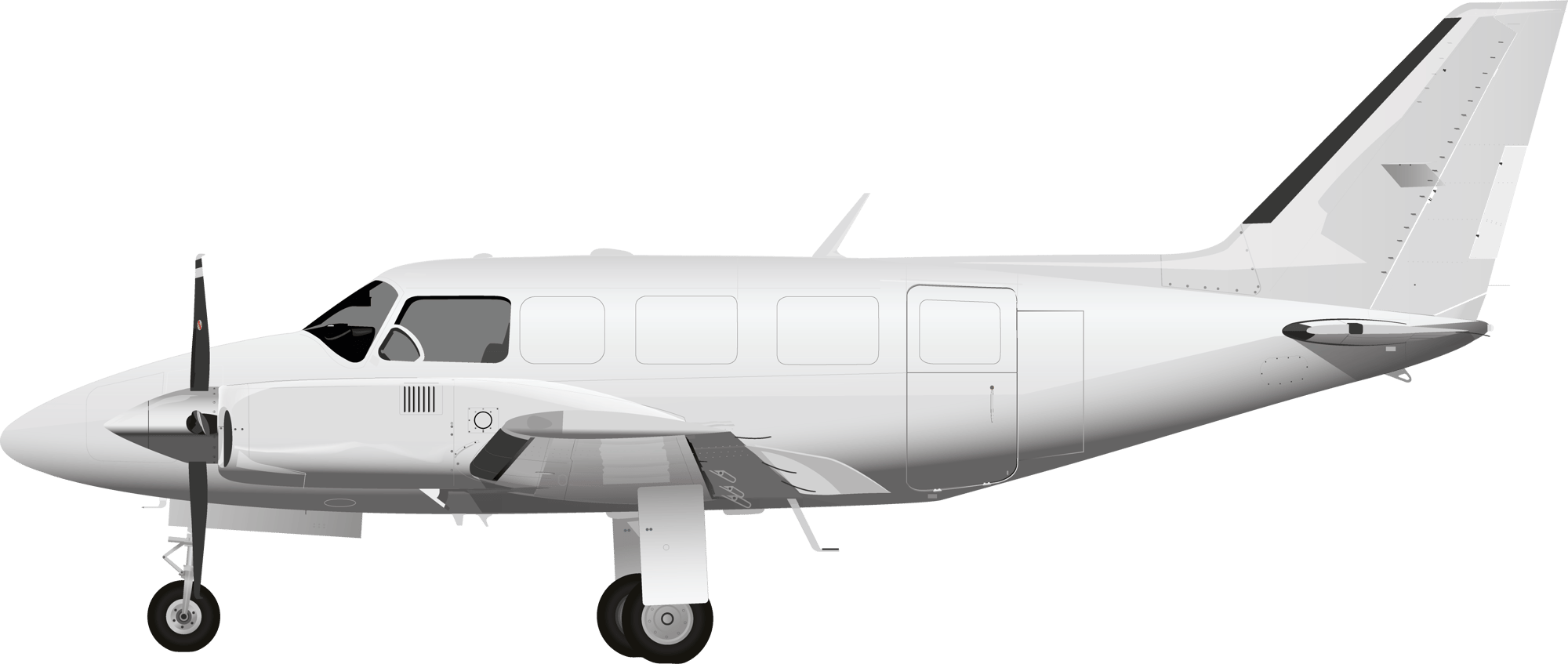Piper PA-31
This cargo version of the successful Piper Navajo is ideal for urgent deliveries of supplies into small airports and airfields. Twin-engined, it is known for high reliability and good performance.
Versatile Twin-Turbo Aircraft
A Reliable Cargo and Commuter Solution
The Piper PA-31 is a twin-turbocharged utility aircraft designed as a corporate aircraft, commuter transporter from regional airports to primary hubs, and as a freighter for light cargo.
In the passenger role, the seats can be configured to seat up to 9 passengers. Removable seats and large rear doors make it suitable for air ambulance or mixed missions. With the seats removed, the aircraft performs well for cargo-only operations.
The aircraft is widely used due to its reliability and performance. It has excellent short takeoff and landing performance and is able to operate from small rural airstrips, making it ideal for bush flying and island hopping. Its turbocharged piston engines are more economical to run and maintain than similar turboprop aircraft, which is especially useful for operators in short to medium-range sectors.
Choose AirFreight.com and get the right aircraft for your shipment. Let our concierge-level customer service and complete shipment flexibility get your delivery where it needs to be when you need it there.
Exclusive use of aircraft, ensuring no conflicting priorities
24/7/365 service availability for whenever you need transport
Platinum-level service and timing to reduce stress
In-flight tracking for accurate delivery status information
Cargo Capacity & Access
The PA-31 is a solid choice for short to medium-haul operations with roughly 17 feet of interior length when configured for cargo. It can handle bulky but not overly tall items. Rear and side cargo doors make it easy to load and unload. The cargo area holds approximately 140 cubic feet of cargo with a maximum weight of approximately 1,200 pounds.
The interior is equipped with tie-down locations and netting to secure loads. Cargo and passenger loading is through a single door located aft of the wing on the left side of the aircraft. One side of the main door can be opened to board crew and passengers, and a second panel to the right of the main doorway can be opened to increase the entry size to 75 inches in width and 55 inches in height.
TYPES OF CARGO
The cargo space is ideal for transporting:
Bulk containers.
Small freight and packages.
Miscellaneous loose cargo.
Express mail.
Perishable goods such as seafood and pharmaceuticals.
Top Down Cutaway
Main Deck
Side Cargo Door
Width: 40 in
Height: 40 in
Side Cargo Doors
Door 1
Width: 26 in
Height: 40 in
Door 2
Width: 14 in
Height: 17.7 in
Max Payload
Cubic feet: 1,348
Weight: 1,200

Range & Routes
With its advantages in low-speed handling, moderate runway requirements, and ability to operate on rural or gravel strips, the PA-31 is best used for regional hauls or point-to-point hops between isolated communities.
Airport Requirements
While the PA-31 operates well from regional airports with asphalt or concrete runways, it is equally capable in rugged, underdeveloped areas with limited infrastructure. It can take off and land on compacted gravel or dirt strips with limited length and in rough conditions.
Taxiway Width: The minimum recommended edge-to-edge width of a taxiway for the aircraft is 80 feet at standard airports. However, in rural or remote locations, the aircraft can operate on taxiways as narrow as 40 to 50 feet due to its excellent handling.
Parking Apron Space: If available, the recommended space around the aircraft needed for ground service equipment is 70 feet x 70 feet to accommodate its wingspan and clearance for service vehicles for loading, unloading, and fueling.
Ground Handling: Manual handling of light cargo, small containers, and loose packages is recommended. The aircraft has a steerable nosewheel, so a tow tractor for pushback or tow is optional.
Fueling: Refueling may be carried out using fuel trucks. The aircraft’s fuel capacity is up to 190 gallons, depending on the payload and flight distance.
Power and Air Support: The PA-31 doesn’t necessarily require a ground power unit in normal operations but one could be useful in cold weather, during frequent stops to preserve battery life, or maintenance checks of powered systems.
Runway Requirements
Takeoff Runway Length: At maximum payload, the PA-31 typically requires only 1,500 feet of runway for takeoff. With lighter payloads, the aircraft can take off on even shorter runways. This requirement may vary based on altitude, temperature, and wind conditions. High-altitude airports with elevations over 8,000 feet may require slightly longer runways due to lower air density.
Landing Runway Length: At maximum payload, the aircraft typically requires a runway length of only 1,300 feet, but shorter runways are possible with lighter cargo or when empty. Wet, icy, or unpaved runways may increase the minimum landing distance required for safe operation.
Crew
The PA-31 can be flown with one pilot. Additional cargo support personnel may be assigned to the flight by the carrier to monitor the cargo and coordinate precise end-to-end delivery.
KEY AIRCRAFT SPECIFICATIONS
Length
33 feet
Wingspan
41 feet
Maximum Takeoff Weight
6,500 pounds
Maximum Payload
Approximately 1,200 pounds
Range
1,165 miles with a full payload
Cargo Volume
Approximately 140 cubic feet
Cruise Speed
240 miles per hour
Engines
Typically equipped with two Lycoming TIO-540-A turbocharged piston engines
We’ve Got the Solution for Your Urgent Shipment
Whether it’s a single parcel or a truckload of pallets, our dedicated team of experts will help you select the best solution, ensuring your delivery gets where it needs to be on time and at an affordable price.
Sending in the Replacement
When you contact AirFreight.com to arrange an expedited air freight shipment, you can expect efficient, personalized service from start to finish. You’ll be assigned a dedicated Expeditor to handle every detail of your shipment, eliminating the need to navigate phone menus or repeat information. A single call or email is often all it takes for AirFreight.com to handle the rest.
The Challenge
What likely began as a misguided prank ended up making multiple cycles on the local evening news. With the owner publicly asking for its return, the community expressing outrage, and the police opening a tip line, it was probably too embarrassing for the perpetrators to make it right.
Running a wildly popular bar for both locals and tourists, you expect these things. It was just terrible timing. The bar had been planning its 50th anniversary with a weeklong celebration for almost a year, and now their selfie-attracting, ten-foot, red-and-gold lighted sign with chaser lights was gone. Unceremoniously removed from the wall outside the bar and carried away in the early morning hours.
Three weeks until the celebration wasn’t much time to plan for a replacement, but the self-appointed community action committee was on the job—raising funds with the help of die-hard customers and selfie-obsessed tourists alike. Everyone wanted to help in some way.
By chance, the original sign crafters, seven hundred miles away, had seen the now-national story and offered to fabricate an exact replica, which had been originally created by the previous generation of crafters. They still had the original plans stored in their files and could get it done just in time for the celebration kickoff—with no time to spare. With that in play, the issue was less about replicating the sign—and more about how they were going to get it here.
Having some experience in shipping signs with tight deadlines, the sign crafters told the bar they would take responsibility for arranging shipment of the sign if they would arrange for installers and electricians to be standing by for sign’s arrival. The bar happily agreed.
How We Solve It
The sign crafters called their Expeditor at Airfreight.com and shared the story. They had a general idea of a plan and the timetable but left it in the Expeditor’s hands to work out the details and coordinate with the different parties. The bar, although a popular tourist attraction, was in a remote area you couldn’t just drive to, and there were no serviceable airports nearby. Arranging transport from the sign crafters building to the local airport and loading the sign onto the aircraft would be easy. Landing the aircraft at or near the destination was still a question.
Since the sign was expected to be completed a day, maybe two days before the celebration, expediting the shipment to the closest airport and then transferring to a truck, and then a boat, and then a truck again would eat up the necessary installation time. The Expeditor zoomed into the area with a mapping system and noticed after several minutes what looked like a large, flat, dirt field a mile from the bar with a small portion occupied by what looked like a construction yard. The Expeditor phoned the bar…
The bar confirmed the area was large and flat and that the owner of the land and the heavy equipment construction company was a friend who “owed him a favor”. The next day, a big yellow and black grader with a massive horizontal blade extending out to each side was seen casually driving back and forth for several hours, making U-turns to line up in the opposite direction every 1,200 feet.
One day out, it was early morning and the weather was forecast for a perfect flight. The sign had been built in two pieces, top and bottom, for easier maneuvering into and out of the chartered aircraft. The 680-mile flight would take about three hours at the aircraft’s standard cruise speed. The installers were put on notice to expect the sign later that morning. The Expeditor, having orchestrated all of the moving parts between the groups for the past week, provided in-flight tracking and updates so everyone would know exactly when to expect the arrival.
Three hours later, with two pickup trucks and a crowd of curious town’s people standing by, the aircraft made a couple of passes and then landed effortlessly onto the dirt strip before making a U-turn to taxi back to the pickup trucks. The smiles on the people’s faces turned into jubilation when the pilot opened the rear door and asked, “Did anyone order a sign?”
The next night, with hundreds of locals and tourists gathered around the outside of the bar, speeches were made expressing immense gratitude for all those who played a part in making that moment a reality, and the sign was lighted for the first time.
One call or email to Airfreight.com could solve a seemingly insurmountable problem when all else fails. Our Expeditors are experts in their field and are known for their ability to look at problems a little differently to save you time and money in the long run.
Reach out today, and let’s solve your urgent shipping needs. Either I or a member of the team will be with you from start to finish.
CALL NOW
Air Charter Freight
Whether facing ultracritical deliverydeadlines or arranging transport from aremote location, it’s vital to use the rightaircraft. Here’s what makes us special—and key information about our fleet.
Blog and Resource Center
How AirFreight.com Solved a PGA Tour Shipping Emergency
Learn how AirFreight.com located a lost shipment and helped save the PGA Golf Tour.
How AirFreight.com Saved The Farm By Solving A Major Shipping Delay
Learn how we saved a Montana-based artisanal farm thousands of dollars by expediting a shipment of perishable goods.
Expedited Shipping Vendor Comparison
We’ve done the research for you. This vendor comparison sheet breaks down how AirFreight.com stacks up against the competition.



